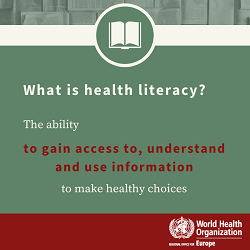Health literacy counts as academic competence in Finnish schools

In Finnish national school curricula, health literacy is introduced as a competence to help make sound health decisions, and to identify and work on the factors that affect one’s own health and well-being.
In an attempt to promote the learning of health-related competencies, health literacy instruction has been adopted as a compulsory part of the curriculum for primary, secondary and upper secondary school students in Finland.
Health literacy – an important determinant for health
From the public health perspective, the improvement of health literacy among adolescents has the potential to contribute to tackling disparities in health. “Health literacy remains a clear determinant of health and the health behaviour of adolescents,” says Leena Paakkari, a senior lecturer at the Faculty of Sport and Health Sciences, University of Jyväskylä, in central Finland.
Referring to a WHO collaborative Health Behaviour in School-aged Children (HBSC) study, Paakkari notes that adolescents with higher levels of health literacy generally report better self-rated health and self-esteem, more physical activity, less smoking and use of alcohol, as well as better sleeping habits, among other benefits.
Finnish national core curriculum and health literacy
Finnish pupils are now among the best informed about health in Europe. This is partly due to the teaching of health literacy in schools through health education, which Finnish pupils rate as one of their most preferred subjects. Curriculum-based health literacy is a component which ensures that all school-aged children are offered the opportunity to acquire the competencies needed to promote and sustain their health.
“Twenty years ago, there was a degree of urgency after several large-scale surveys had shown alarming changes in adolescents’ health and health behaviour,” says Lasse Kannas, professor emeritus at the University of Jyväskylä. “It was realized that there was a need to foster the development of health-related competencies, that is, health literacy in schools. At that time, the teaching of health issues was integrated into other school subjects which was seen to be insufficient to develop essential health-related competencies in schools.”
Various stakeholders, such as the Ministry of Education, Ministry of Health and Social Affairs, public health institutes, public health NGOs, teacher associations, and academics from various universities, shared the same concern about the health and well-being of adolescents and the vision about introducing a new independent and mandatory school subject. As of 2004, basic as well as upper secondary education have introduced time and space for health literacy instruction.
“At the end of upper secondary education, health literacy is measured as part of the Finnish Matriculation Examination, if students select health education to be included into their test,” says Paakkari. “The grades gained can be used in applying to university and other institutions of higher education. Hence, health literacy serves also as an academic competence.”
University-level teacher training for health literacy
In Finland, all health education teachers must go through a university-level health education teacher training program to become qualified to teach the subject – one way to secure the quality of teaching. Also, several publishers offer health education textbooks, e-learning materials, teacher’s guides and exercise books for pupils. In basic education, municipalities and schools must guarantee that all pupils have free access to all relevant teaching materials.



